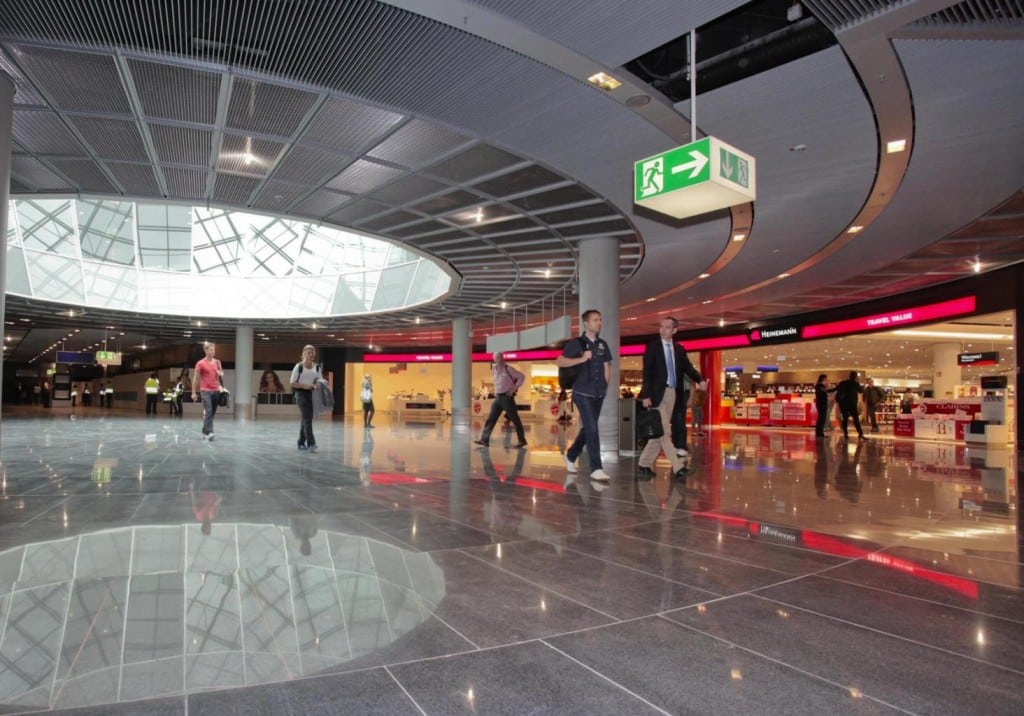Skift Take
Gates that can handle superjumbo jets, self-boarding gates, and a clean open design makes A-Plus an exemplar concourse that sets high expectations for Berlin airport’s long-delayed debut.
A pool of light is reflected on dome-like panels that might tempt the most harried of passengers to pause and reflect.
Like most buildings in Frankfurt, where the average monthly sunshine quota is a third less than Rome’s, the architecture of its airport’s new concourse, A-Plus, centres around the area which captures light.
A-Plus, whose total floor space fits 25 football pitches, allows Germany’s biggest hub to serve up to six million additional passengers annually, or a total of around 65 million passengers per year. The facility is used solely by Lufthansa and its 26 Star Alliance airline partners.
The 700 million euro concourse opened to flight operations on October 10, about six months after a German court ruled in favour of a ban of flights from 11 pm to 5 am at Europe’s third busiest airport and a year after it opened its fourth runway.

A-Plus was tailor-made for widebody aircraft like the Airbus 380 superjumbo and the Boeing B747 family. It has seven docking positions, four for double-decker jets like the A380 and three more for aircraft like the Boeing 747-8 and Airbus 340.
If the four A380 positions are not required, it is possible for two short-range aircraft like the Airbus A321 to dock here. The seven positions could therefore process up to 11 narrow-body aircraft.
As a result, nearly all long-distance flights can be processed by Lufthansa directly at the airport terminal, cutting the number of aircraft parking at remote apron positions. That also reduces those annoying bus rides for travellers.
The new concourse cuts passenger walking time to reach the gate of a connecting flight to the U.S. from 60 minutes to 45 minutes, thanks mainly to the flexible positioning possibilities at the docking stations. They will also spend less time scratching their heads because signs are now clearer and their number has been reduced to the minimum.
A-Plus has five lounges clustered near the atrium on different levels of the four-storey building.
At the 1,000 square metre First Class Lounge there are shower rooms, two bathtubs, a six-metre-long whiskey bar with 80 whiskey brands and two “quiet rooms.”
The Senator or business lounge in the Non-Schengen area is the largest Lufthansa lounge worldwide, with three massage chairs, a room for smokers and spacious leather seats occupying the 2,100 square metre space.
 Retail Therapy in Transit
Retail Therapy in Transit
At the atrium, a rotunda linking the new facility with the A, B and C concourses at Terminal 1, is what the airport’s operator Fraport AG calls the “marketplace”.
The marketplace is crucial to Fraport, which makes more money from its shops, restaurants and parking lots combined than from fees it charges airlines for flight operations.
Last year, the 305.3 million euros in earnings before income, tax, depreciation and amortisation (EBITDA) from Retail & Real Estate was not only the most profitable of Fraport’s four divisions. It was also the biggest contributor, at 38 percent, to group EBITDA.
This meant that even at the height of the recession in 2009, Fraport was raking in a margin of 26 percent while Lufthansa had only 8.5 percent, according to one person familiar with the airport operations. He did not want to be named.
Unlike at Charles de Gaulle Airport, where a passenger with seven hours to kill might venture to the Eiffel Tower, an hour’s taxi ride away, the average traveller caught at Frankfurt’s airport might be tempted to window shop at Longchamp, Tumi, Gucci, Dolce & Gabbana or Mulberry at A-Plus rather than visit the birthplace of Johann Wolfgang von Goethe, located 20 minutes away by commuter train.

The Daily Newsletter
Our daily coverage of the global travel industry. Written by editors and analysts from across Skift’s brands.
Have a confidential tip for Skift? Get in touch